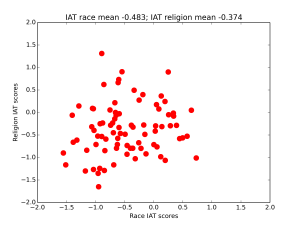August 8, 2014, by Robin Scaife
Report on our first testing
Before the undergraduates escaped for their summer break we managed to subject some of them to the first large-scale trial of our IAT software. 83 participants undertook 2 positive/negative association IATs (a black vs white racial IAT & a Muslim vs Non-Muslim religion IAT). They also answered a series of explicit question about their views on racial and religious diversity. These included sematic differential questions such as “in general how do you feel about Muslims?” on a series of scales (cold-warm, suspicious-trusting, positive-negative, friendly-hostile). As well as a series of questions on a 7 point agree-disagree Likert scale, which were designed to test a variety of factors including their beliefs about racial and religious diversity and their perception of moral and social norms regarding prejudice.
Both the IAT’s produced negative average scores which indicate prejudice against black people (Race IAT Mean: -0.483) and Muslims (Religion IAT Mean: -0.374). The race IAT produced a larger negative score by -0.109. This difference drops to -0.065 if we exclude the Muslim participants (who all had positive Muslim associations) from the analysis. There was some correlation between the race and religion IAT scores indicating that prejudice against one group gives some prediction that you are likely to be prejudices against the other (see graph).
The answers to our explicit questions indicate that the undergraduates share our understanding of the prevailing moral norms regarding prejudice. The vast majority strongly indicated that it is not morally acceptable to make judgements about people based on their race, they would feel guilty if they had behaved in a prejudiced way towards different racial groups and claimed they were motivated by their values to avoid prejudice on the basis of racial identity. The average of these responses was close to ceiling (over 6 on the 7 point scale). We found similar but marginally less strong results for religious prejudice. Similarly the semantic differentials revealed that most participants rate white people, black people and Muslims equally. Another good indicator that participants feel under pressure not to be seen as prejudice is that in the debrief many of them reported that they were worried their responses might make them come across as racist.
Our explicit questions covered issues such as the moral unacceptability of prejudice, feelings of guilt about being prejudice and the social norms governing prejudice. One potential issue was that merely getting participants to think about these issues (by answering our questions) might influence their performance on the IAT. In order to test if answering the explicit questions influenced performance on the IATs we had half our participants answer the questions prior to taking the IATs and the other half after taking the IATs. Our analysis indicates that taking part in the explicit attitudes survey did not have a significant impact on IAT scores.
We can draw a number of useful conclusions from these results which will help us with subsequent experiments:
• We get none-zero IAT scores, indicating prejudice. The fact that we get similar results to other research groups using the IAT suggests that our IAT programme is working as it should. We also now have a baseline for scores on these particular IATs amongst our undergraduates.
• As expected, undergraduates do strongly subscribe to the social norms about prejudice being bad and are concerned about being seen to discriminate.
• Asking people explicit questions about their perception of social norms governing prejudice does not significantly influence IAT performance.
• We will focus on black vs white racial prejudice in our next experiment. This is because the Race IAT produces slightly larger negative IAT scores and our explicit measures indicate slightly stronger social norms against racial prejudice than religious prejudice.
No comments yet, fill out a comment to be the first


Leave a Reply